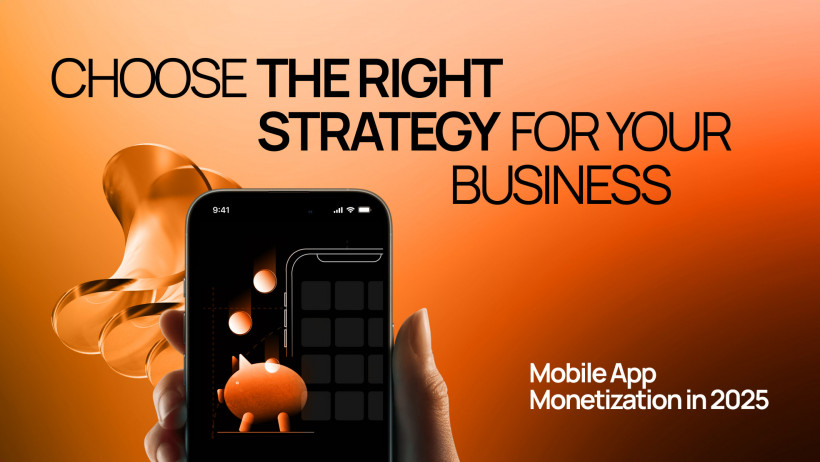So, you’ve built a great app. It’s smooth, user-friendly, and solves a real problem. But here’s the real challenge: how to monetize a mobile app without losing users’ trust or momentum?
In 2025, competition is fiercer than ever. With millions of apps in stores, users have endless choices, and only those with a smart app monetization plan stand out. The good news? Developers now have more options than ever — from freemium and subscriptions to in-app purchases, ads, and hybrid approaches.
In this article, we’ll explore the top app monetization strategies 2025 brings, weigh their pros and cons, and share practical tips to help you pick the right revenue model for your app and your users.
A Great App Needs a Great Monetization Plan
Building an app without a monetization plan is like opening a restaurant without deciding whether you’ll charge for meals: people might enjoy the food, but your business won’t last long. The reality is simple: even the most brilliant app needs a clear revenue model to survive, grow, and keep delivering value to users.
So, what’s new in 2025?
- User expectations are higher. People no longer tolerate clunky ads, unclear pricing, or hidden charges. They want transparency and value at every step.
- Competition is fierce. With thousands of new apps entering the market every month, only those with well-chosen app revenue models can carve out their space and stay profitable.
- App store rules are evolving. Policies on subscriptions, in-app transactions, and app store commission fees are changing, giving developers both new opportunities and fresh challenges.
Here’s How Successful Apps Are Making Money in 2025
From fitness apps to gaming giants, successful companies are using a mix of freemium models, subscriptions, digital purchases inside the app, and ads to maximize ROI. The trend? Hybrid monetization strategies are gaining popularity, combining multiple revenue streams to reduce risk and increase stability.
For example:
- A meditation app might combine a free tier with a paywall strategy for premium guided sessions.
- A game might offer in-app purchases for extra lives alongside rewarded ads.
- A productivity app may rely on a subscription model with tiered pricing.
Why Monetization Strategy Matters
Impact on Growth and Retention
A poorly chosen strategy can scare away users or lower engagement. On the other hand, the right model helps you:
- Build trust.
- Increase revenue per user.
- Keep churn under control.
Balancing User Experience with Revenue
The challenge is striking the perfect balance. Push too many ads, and users leave. Charge too much upfront, and you’ll struggle with downloads. A user-first monetization plan respects the customer journey while ensuring steady revenue.
Top Monetization Models in 2025

Freemium
The freemium approach remains a top choice. Users get a taste of the app for free, but premium features are locked behind a paywall strategy.
Pros:
- Wide user acquisition.
- Low entry barrier.
Cons:
- Requires strong premium features to convert.
Subscription-Based Apps
Think Netflix, Spotify, or top productivity apps. Subscription-based apps provide ongoing value and charge users monthly or annually.
Pros:
- Predictable recurring revenue.
- High customer lifetime value (LTV).
Cons:
- Users may cancel quickly if value isn’t clear.
In-App Purchases
Especially popular in gaming, in-app purchases (IAPs) let users buy extra content, currency, or tools.
Pros:
- Flexible, scalable revenue.
- Users spend based on engagement.
Cons:
- Risk of “pay-to-win” backlash.
Paid Apps
Still relevant, though less common. Users pay once to download.
Pros:
- Immediate revenue.
- Works well for niche or pro apps.
Cons:
- High upfront barrier.
- Lower user base compared to free apps.
Advertising in Apps
Ads in apps continue to be a major source of income. Formats include:
- Rewarded ads: users watch an ad to unlock something.
- Banner ads: simple, always visible.
- Interstitial ads: full-screen, shown at breaks.
Pros:
- Free access keeps users engaged.
- Scalable with ad networks like AdMob and Facebook Audience Network.
Cons:
- Ad fatigue if overused.
- Requires large user base.
Choosing the Right Model for Your App
App Category Considerations
- Games: often rely on IAPs + ads.
- Productivity apps: better suited for subscriptions.
- Media/entertainment apps: thrive on freemium + subscriptions.
User Base and Engagement Level
- Highly engaged users = good for IAPs and subscriptions.
- Casual users = better with ads or freemium.
Geography and Market Behavior
Monetization isn’t one-size-fits-all. For instance:
- US/EU users are more open to subscriptions.
- Emerging markets may lean towards ad-supported free apps.
Combining Models for Hybrid Monetization
When and How to Mix Strategies
Many apps succeed by blending models:
- Freemium + subscriptions (Spotify).
- IAPs + rewarded ads (mobile games).
- Subscriptions + advertising (news apps).
Best Practices from Top Apps
- Keep the user journey smooth — no disruptive monetization.
- Use data-driven insights to adjust offers.
- Test different pricing tiers and ad placements.
Key Metrics to Track Monetization Performance

If you can’t measure it, you can’t improve it. Key metrics include:
- ARPU (Average Revenue per User) — your monetization benchmark.
- LTV (Lifetime Value) — how much a user is worth over time.
- Retention rates — how long users stick around.
- Conversion rates — free → paid or ad interactions.
- User churn vs monetization — are people leaving after paywalls?
These metrics help fine-tune your app monetization strategies 2025 for long-term success.
Challenges and Pitfalls
Even the smartest app monetization strategies 2025 aren’t without risks. Developers often face common pitfalls that can limit growth or damage the user experience if not handled carefully.
Over-Monetization
It’s tempting to squeeze revenue out of every interaction, but bombarding users with ads, constant paywalls, or pushy prompts is the fastest way to drive churn. Users today expect smooth, respectful experiences. If your app feels more like a cash machine than a helpful tool, they’ll simply uninstall and move on.
Ad Fatigue
Even the most engaging ad formats, like rewarded ads, lose their impact if they’re shown too often. Banner ads can become invisible (“banner blindness”), and interstitial ads may frustrate users if they interrupt key moments. Finding the right balance between ad frequency and user satisfaction is essential to keep engagement high.
App Store Commission Fees
Apple and Google still charge commissions of up to 30% on in-app transactions, cutting into developer profits. In 2025, alternative payment options and regional regulations (especially in the EU and parts of Asia) are giving developers more flexibility. Still, navigating these policies can be complex, and failing to adapt may leave money on the table.
Other Hidden Challenges
- User churn vs monetization: introducing paywalls too early can push users away before they see value.
- Market differences: strategies that work in the US may fail in markets where disposable income is lower or user expectations differ.
- Compliance and security: integrating billing systems means handling sensitive user data — one mistake can cost both trust and revenue.
The bottom line? Monetization is a balancing act. Push too hard, and you risk alienating users. Play it too safe, and you might not generate enough revenue to sustain your app. The sweet spot lies in testing, analyzing, and adjusting your strategy as your user base evolves.
How WEZOM Helps You Monetize Your App Effectively
At WEZOM, we know that monetization is not one-size-fits-all. Every app has its own audience, engagement patterns, and market challenges, and a strategy that works for a gaming app may not be right for a fintech or eLearning product. That’s why we take a personalized, data-driven approach to maximize your ROI.
Here’s how we can support you:
- Monetization strategy planning — we dive deep into your app’s niche, target audience, and competitive landscape to design a tailored monetization roadmap that matches both your short-term goals and long-term vision.
- Analytics and optimization — we don’t just set up a model and leave it. Our team continuously monitors key metrics such as ARPU, LTV, churn, and conversion rates to make sure your revenue keeps growing without compromising user experience.
- Integration with ad platforms and billing systems — from connecting your app to trusted ad networks like AdMob and Facebook Audience Network to implementing secure payment gateways, we ensure a smooth, reliable setup.
- Ongoing support and scaling — as your app grows, so do your monetization opportunities. We help you test new formats, introduce hybrid models, and adapt to app store policy changes.
Whether you’re launching your first MVP or optimizing a mature app with millions of users, WEZOM will help you design, test, and scale the right approach. With us, you don’t just get a strategy, you get a partner who cares about both your revenue and your users.

Conclusion
In 2025, the question isn’t whether you should monetize — it’s how to monetize a mobile app in a way that balances user experience with business growth. From freemium models to hybrid monetization approaches, there are plenty of paths to success.
The most successful apps aren’t just chasing quick revenue; they’re building long-term relationships with their users. That means choosing monetization methods that feel natural, add value, and encourage people to keep coming back.
Remember: the market is constantly shifting. New ad formats, alternative payment options, and evolving user habits will continue to reshape the landscape. The winners will be those who stay flexible, track their metrics closely, and adapt fast.
So, are you ready to explore the best way to monetize apps for your business? Let’s build a strategy that not only boosts revenue but also keeps your users engaged and loyal.

